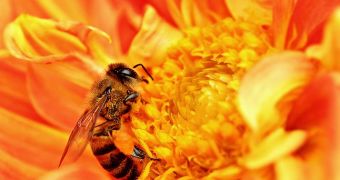Scientists with the University of Sussex, in the United Kingdom, have determined in a new study that exposure to pesticides makes bees collect just half of their usual amount of pollen. This is a very significant finding, since pollen is the only source of proteins for bees and their offspring.
These results may partially explain why so many bee colonies around the world are currently declining, with some in free fall. Pesticides have long since been proposed as a potential explanation for this phenomenon, but intense lobby from chemical manufacturers have prevented any real progress in investigations on this matter.
The new research was focused entirely on a class of chemicals known as neonicotinoid pesticides, which are heavily used in agriculture nowadays. Its research provides a novel starting point in analyzing how these substances affect bees of all types. Use of neonicotinoid pesticides has been banned for two years in the European Union, starting in December 2013.
This measure was taken after a series of studies demonstrated a direct harmful link between these substances and the health of honeybees and bumblebees. This decision was very difficult for the EU to make, since neonicotinoids are the most popular pesticides in the world.
“Pollen is the only source of protein that bees have, and it is vital for rearing their young. Collecting it is fiddly, slow work for the bees and intoxicated bees become much worse at it. Without much pollen, nests will inevitably struggle,” says Sussex investigator and study leader, professor Dave Goulson.
In experiments, the UK team was able to determine that bees exposed to the neonicotinoid imidacloprid brought back pollen from 40 percent of their trips. Unexposed bees brought back a full cargo from 63 percent of their trips. In terms of amount, exposed bees carried 31 percent less pollen per flight than their unexposed counterparts.
When these measurements were integrated, the team found that nests where bees had been exposed to pesticides received around 57 percent less pollen than nests in areas that had not been sprayed with these chemicals. Details of the study appear in the latest issue of the journal Ecotoxicology, Our World reports.
“This is a very important study, because it provides further detail on how bumblebee foraging is made less efficient by exposure to imidacloprid at these levels,” comments University of Cambridge ecologist Lynn Dicks.

 14 DAY TRIAL //
14 DAY TRIAL //